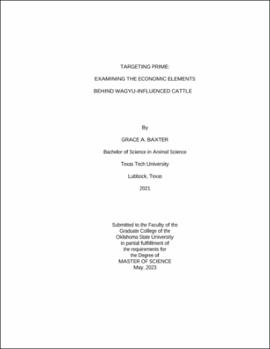| dc.contributor.advisor | Raper, Kellie Curry | |
| dc.contributor.author | Baxter, Grace A. | |
| dc.date.accessioned | 2023-08-25T20:06:16Z | |
| dc.date.available | 2023-08-25T20:06:16Z | |
| dc.date.issued | 2023-05 | |
| dc.identifier.uri | https://hdl.handle.net/11244/338939 | |
| dc.description.abstract | Wagyu beef is an increasingly popular product among today’s U.S. beef consumers because of its taste and tenderness resulting from high amounts of marbling and unique healthy fat composition. Low average daily gains and extended production cycles of Wagyu cattle have encouraged producers to crossbreed Wagyu with Angus, a popular U.S. breed of British descent, to attain these desired carcass and flavor characteristics more efficiently. Progeny from this crossbreeding effort are called Wangus. Most research conducted over Wagyu cattle has only examined physical differences between Wagyu and conventional beef breeds, but with no economic analysis. Objective 1 analyzes price composition for fed Angus cattle and for Wangus cattle of varying Wagyu genetic influence, including whether price premiums are associated solely with carcass characteristics or if a component of price is driven by perceived quality attributable to the Wagyu name. Research uses a hedonic model analysis of Wangus fed cattle price components. Objective 2 compares feedlot profitability across sex, feedlot start weight, and various genetic percentages in Wangus cattle with an ANOVA test. The Analysis of Variance (ANOVA) procedure is implemented with Tukey’s method to determine pairwise differences among subgroups. Results indicate premiums exist not only for certain carcass attributes but also for association with Wagyu beef. While 25% and 12.5% Wagyu cattle may not have American Wagyu marketing advantages, producers may receive premiums from these cattle based on buyers’ perceptions of Wagyu and an increased rate of cattle achieving USDA Prime quality grades. Significant premiums exist for reaching USDA Prime quality grades. Discounts are significant for USDA yield grades above 3. The analysis found differences exist in feedlot profitability among Angus and Wangus genetics. Wangus cattle with 25% and 12.5% Wagyu on average have higher net returns compared to Angus. On average, 50% Wagyu had the lowest net returns. Unexpectedly, there was no statistical difference in average profitability between steers and heifers. Differences exist in profitability among feedlot start weight groups with lighter weight cattle having higher mean net returns than heavier cattle. Results concluded price premiums could be achieved while minimizing losses of additional costs typically associated with Wagyu. | |
| dc.format | application/pdf | |
| dc.language | en_US | |
| dc.rights | Copyright is held by the author who has granted the Oklahoma State University Library the non-exclusive right to share this material in its institutional repository. Contact Digital Library Services at lib-dls@okstate.edu or 405-744-9161 for the permission policy on the use, reproduction or distribution of this material. | |
| dc.title | Targeting prime: Examining the economic elements behind Wagyu-influenced cattle | |
| dc.contributor.committeeMember | Peel, Derrell | |
| dc.contributor.committeeMember | Shear, Hannah | |
| osu.filename | Baxter_okstate_0664M_18150.pdf | |
| osu.accesstype | Open Access | |
| dc.type.genre | Thesis | |
| dc.type.material | Text | |
| dc.subject.keywords | cattle crossbreeding | |
| dc.subject.keywords | feedlot profitability | |
| dc.subject.keywords | price premiums | |
| dc.subject.keywords | specialty beef | |
| dc.subject.keywords | USDA prime | |
| dc.subject.keywords | Wagyu | |
| thesis.degree.discipline | Agricultural Economics | |
| thesis.degree.grantor | Oklahoma State University | |
